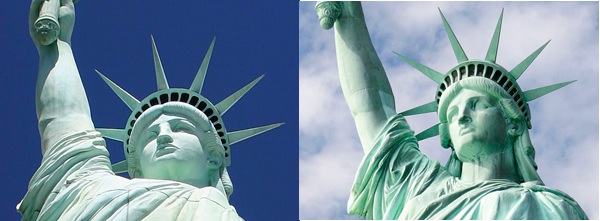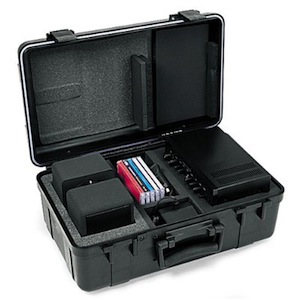The Latest from Boing Boing |  |
- Playboy Mansion legionella outbreak traced to hot tub
- New Zealand's 3-strikes rule can go into effect in September
- Friday Freak-Out: It's A Beautiful Day's "White Bird" (1971)
- Cambridge SoundWorks Portable Speaker System
- Guns & Gardens Ep. 5 - The DIY Zombie Apocalypse Survival Guide
- Japan Quake sound captured by underwater microphones (or "hydrophones")
- Final call for entries in Yuri's Night space art contest (prize: Zero-G flight on Ilyushin 76!)
- Make: Projects -- build a micro FM transmitter
- Roots music magnate Chris Strachwitz
- Tracklist for William Shatner's upcoming album "Searching for Major Tom"
- Dorota: Mystical Rainbow
- To do in NYC April 17: "And I Am Not Lying"
- Home value chart updated 1890-2011
- McGraw-Hill iPhone / iPad apps for free: Monster Squeeze, Tric-Trac
- iOS apps for kindergartners? (open thread)
- Crab attack!
- Why does Android marketplace link apps for gay men and apps for sex offenders?
- Tsunami characters
- World's creepiest product for kids from 1959
- The Starlighter Quartet
- Trailer for upcoming Planet of the Apes movie
- US defense contractor building "secret microwave gun"
- Beat "bootcamp" and the On The Road movie
- Gullibility may be early sign of dementia
- Young bonobo may be expressing symptoms of autism
- Shrooms limit brain blood flow and connections
- Thinking critically about the so-called "gay caveman"
- USPS accidentally issues Vegas Statue of Liberty stamp
- Genes, language, and how we study human pre-history
- "Collection" t-shirt of space missions
| Playboy Mansion legionella outbreak traced to hot tub Posted: 15 Apr 2011 07:15 PM PDT Health officials in Los Angeles used blogs, Twitter and Facebook to track down the source of a legionella bacteria infection that sickened more than a hundred Playboy Mansion visitors. The verdict: "a whirlpool spa" at the iconic mansion. I think they mean the famed grotto (I've been there on a reporting mission once, fully clothed!), but the article doesn't specify. (LA Times) |
| New Zealand's 3-strikes rule can go into effect in September Posted: 14 Apr 2011 11:44 PM PDT This week, New Zealand's Parliament rushed in its controversial 3-strikes Internet disconnection law, using emergency procedures invoked to help victims of the Christchurch earthquake for cover. The law allows whole families to be disconnected from the Internet if someone using their Internet connection is accused -- without proof -- of three acts of copyright infringement. The NZ government and press say that this draconian law only goes into effect if infringement doesn't decline over the next two years. But the reality is that 3-strikes can go into effect as early as September, based on consultation solely with rightsholders, with no need for public consultation. Juha sez, "Disconnections under the new copyright law in New Zealand can in fact be activated any time after September 1 when the Act comes into force. This would happen if the notice-and-notice regime where rights holders can take infringers to the Copyright Tribunal is deemed not to be working. IP lawyers I've talked to expect the regime to fail due to the sheer volume of notices and cases, as per overseas experience. The Copyright Tribunal will be staffed by five IP lawyers. At this stage, we don't know if the government will allow public consultation and submissions, should it decide to activate the Internet Termination Penalty in the new law. It's not mentioned in the new Copyright Act. The review after two years is to see if mobile data connections should be subject to the new copyright act as well." The majority of us recommend the new section 122PA, which would effect what we believe a workable compromise on this issue. The bill's provisions allowing for Internet suspension would be retained, with modifications, but would not be brought into effect immediately. If evidence indicated that notices alone (and the remedy through the Copyright Tribunal) were not having the desired deterrent effect, the suspension provisions could be activated by Order in Council. The majority of us believe this approach would create the right incentives, with the remedy of suspension able to be brought into effect if needed. We would expect an appropriate timetable for monitoring and review to be developed in consultation with rights holders. We note that a similar approach was recently adopted in the United Kingdom.Copyright (Infringing File Sharing) Amendment Bill 119-2 (2010), Government Bill (Thanks, Juha!) |
| Friday Freak-Out: It's A Beautiful Day's "White Bird" (1971) Posted: 15 Apr 2011 03:03 PM PDT Friday Freak-Out: It's A Beautiful Day performing "White Bird" live at the Fillmore, 1971. From the film Fillmore: The Last Days. |
| Cambridge SoundWorks Portable Speaker System Posted: 15 Apr 2011 02:56 PM PDT  This is, hands-down, the best portable audio system I have ever heard. It takes a few minutes to set-up and pack-up, and you need a power source to run it, but wow! does it have great sound! I have used it for parties, outdoor BBQs, and on vacation and it never fails to sound great. The included speakers and amplifier, the necessary cables, and your iPod, all pack into the included hard case (which also contains the subwoofer). This is, hands-down, the best portable audio system I have ever heard. It takes a few minutes to set-up and pack-up, and you need a power source to run it, but wow! does it have great sound! I have used it for parties, outdoor BBQs, and on vacation and it never fails to sound great. The included speakers and amplifier, the necessary cables, and your iPod, all pack into the included hard case (which also contains the subwoofer).My only gripe is that the connections are all clip-connections rather than banana connections, but Radio Shack and other sources sell small banana-style plugs to use with clip connections, making set-up much easier (no frayed wire ends).
I can't recommend this enough for anyone who wants audiophile-quality music they can take with them to a cabin, condo, RV, or to their backyard as needed. The price is higher than your standard portable units, but Cambridge Sound Works constantly has sales and coupons on the net, making the price a little bit better. In any event, it's well worth even the full list price! There are few things I have come across that are "best of class" but this is certainly one. --Torgny Nilsson Cambridge SoundWorks Model 12 Portable Speaker System
|
| Guns & Gardens Ep. 5 - The DIY Zombie Apocalypse Survival Guide Posted: 15 Apr 2011 02:31 PM PDT [Video Link] Here's the latest episode of Guns & Gardens. I wonder if they belong to my favorite political party (The Guns and Dope Party). |
| Japan Quake sound captured by underwater microphones (or "hydrophones") Posted: 15 Apr 2011 02:18 PM PDT [Video Link]. An AP item about spectrograms and audio files which captured sound waves associated with the March 11 earthquake off the northern coast of Japan. (via @NYTjim) |
| Final call for entries in Yuri's Night space art contest (prize: Zero-G flight on Ilyushin 76!) Posted: 15 Apr 2011 02:08 PM PDT |
| Make: Projects -- build a micro FM transmitter Posted: 15 Apr 2011 01:52 PM PDT  Sean Michael Ragan chose an adorable case to hold his micro FM transmitter. Make: Projects has the complete instructions. Sean Michael Ragan chose an adorable case to hold his micro FM transmitter. Make: Projects has the complete instructions. (A No-Prize shall be awarded to the most sanctimonious comment about FCC rules against RF interference.) |
| Roots music magnate Chris Strachwitz Posted: 15 Apr 2011 02:15 PM PDT   Chris Strachwitz, 79, is the founder of Arhoolie Records, a small, independent, and absolutely incredible record label based in the Bay Area that for 50 years has released an unending stream of obscure and exquisite "down home" roots, blues, folk, and Tejano music. (Strachwitz is also a proprietor of Down Home Music, an equally amazing record (yes, records, but CDs too) shop in El Cerrito, north of Berkeley, California. It should come as no surprise that Strachwitz has his own world class music collection. Indeed, he holds the largest archive of Mexican and Mexican American music on the planet, a total of more than 46,000 recordings mostly on 78s and 45s. Slowly, archivist (and ska-punk trombonist) Antonio Cuellar is digitizing every piece and making them available online through UCLA's Chicano Studies Research Center library. This week's San Francisco Bay Guardian features an interview with Strachwitz and Cuellar. From the SFBG: From Strachwitz's well-documented obsession with tracking down Lightnin' Hopkins to record him in 1959, to his increasingly far-flung forays into the backwoods and swamps of the musically-diverse South, his emphasis has been on excavating the genuine, the raw, and the regionally significant. The diversity of music that Arhoolie publishes and records ranges in style from dirty blues to folk ballads, Cajun zydeco to conjunto. The tie that binds them isn't genre, but emotional content."Hear me howling!" (SFBG) "Hear Me Howling! Blues, Ballads & Beyond: The Arhoolie 50th Anniversary Boxset" (Amazon) |
| Tracklist for William Shatner's upcoming album "Searching for Major Tom" Posted: 15 Apr 2011 01:18 PM PDT  "The song line up for 'Searching for Major Tom' has been announced. WilliamShatner.com is happy to report that the album due out later in 2011 on the Cleopatra Records label will have the following songs..." I've heard his "Iron Man," from an iPhone video captured in the studio by a friend during the recording session. This thing is gonna rule. |
| Posted: 15 Apr 2011 01:03 PM PDT  [Video Link]. Medieval dresses and orgone generators to combat negative vibrations from mobile phones and gaming consoles by Dorota. Everything about this video, right down to the MIDI soundtrack, is unstoppably awesome. Thanks, Robert Popper. |
| To do in NYC April 17: "And I Am Not Lying" Posted: 15 Apr 2011 01:01 PM PDT If you're in NYC on Sunday, April 17th, check out the latest edition of the live improv/storytelling/puppetry/comedy/burlesque show "And I Am Not Lying," put together by BB pal Jeff Simmermon. Starts 8PM at the Kraine theater: 85 East Fourth Street, between Bowery and Second Avenue. More info here, video trailer here, flyer here. |
| Home value chart updated 1890-2011 Posted: 15 Apr 2011 12:54 PM PDT  Barry Ritholtz of The Big Picture says: In 2006, just as the Housing market was peaking, the NYT ran this graphic of the 100-year Case Shiller chart. It showed how radically overvalued Housing had become. Two years later, TBP reader Steve Barry updated that graphic, including the projected Home Price mean reversion. Its time to update this for 2011. Note the 2009 tax credit wiggle.Case Shiller 100 Year Chart (2011 Update) |
| McGraw-Hill iPhone / iPad apps for free: Monster Squeeze, Tric-Trac Posted: 15 Apr 2011 12:47 PM PDT  DealNews points to a bunch of education applications for the iPad and iPhone that McGraw-Hill is giving away (regularly $2 each). I just grabbed them all. The deal ends April 16. McGraw-Hill iPhone / iPad apps for free: Monster Squeeze, Tric-Trac |
| iOS apps for kindergartners? (open thread) Posted: 15 Apr 2011 12:37 PM PDT |
| Posted: 15 Apr 2011 12:29 PM PDT |
| Why does Android marketplace link apps for gay men and apps for sex offenders? Posted: 15 Apr 2011 12:07 PM PDT  Mike Ananny, a postdoctoral scholar at Microsoft Research and fellow at Harvard's Berkman Center for Internet & Society, writes in the Atlantic about a strange Android app discovery: As I was installing Grindr on my Android phone yesterday, I scrolled down to take a look at the list of "related" and "relevant" applications. My jaw dropped. There, first on the list, was "Sex Offender Search," a free application created by Life360 that lets you "find sex offenders near you and protect your child ... so you can keep your family safe." (via danah boyd) |
| Posted: 15 Apr 2011 11:46 AM PDT  Tokyo-based author and translator Matt Alt has a post up today on Altjapan about the history of anthropomorphizing tsunamis in Japan. Japan has a long history of using cute mascot characters in situations that can surprise Westerners. In fact, quite often the more terrifying or distressing a situation, the cuter the visual description of it becomes on official posters here. (via Sean Bonner) |
| World's creepiest product for kids from 1959 Posted: 15 Apr 2011 11:37 AM PDT |
| Posted: 15 Apr 2011 11:31 AM PDT  I'm hopping in my Peel P50 and heading over to the Biltmore Motor Hotel to see The Starlighter Quartet tonight. Check out those handmade guitars! Here's the same photo without the text around it. |
| Trailer for upcoming Planet of the Apes movie Posted: 15 Apr 2011 11:21 AM PDT [Video Link] This looks good. But I still think the John Chambers' ape makeup and the ape tunics from the original are unbeatable. |
| US defense contractor building "secret microwave gun" Posted: 15 Apr 2011 11:05 AM PDT BAE, a U.S. military contractor, is developing a "microwave gun" but won't release details. Wired Danger Room reports that the intent is to use the gun in combat or vessel defense scenarios on the high seas, but my bet is that it will instead be used against the menace of floating frozen burritos that litter arctic waterways. |
| Beat "bootcamp" and the On The Road movie Posted: 15 Apr 2011 10:50 AM PDT  This fall, Jack Kerouac's "On the Road" will finally hit the big screen, directed by Walter Salles and written by Jose Rivera, both of whom worked on The Motorcycle Diaries. Sam Riley stars as Sal Paradise and Garrett Hedlund is Dean Moriarty. Viggo Mortensen took on the William Burroughs-inspired character Old Bull Lee. Over at the Bay Citizen, Scott James updates us on the undertaking, including efforts the cast and crew are making not to fuck up this iconic work of the counterculture. Indeed, the actors and crew even went through a Kerouac "boot camp" led by the likes of Gerald Nicosia, author of the definitive Kerouac bio "Memory Babe: A Critical Biography of Jack Kerouac." From the Bay Citizen: None of the cast and crew were old enough to remember the Beat era, so Nicosia, of Corte Madera, approached the sessions as if he were teaching ancient history, "like I was bringing them the Holy Grail.""'On the Road' Becomes a Movie at Last"
|
| Gullibility may be early sign of dementia Posted: 15 Apr 2011 10:49 AM PDT Elderly people who are increasingly unable to detect sarcasm or lies may be exhibiting early signs of dementia/neurodegenerative diseases, according to University of California scientists. The new research suggests that it might be possible to spot certain neurodegenerative diseases by looking for surprising gullibility in someone who otherwise may seem healthy. This connection has been somewhat obvious for years, as elderly people are sadly more easily suckered by scam artists. (Not to say that being an easy target for a con means one has a neurodegenerative disease.) In this latest work though, he UCSF team used brain scans to show that damage and deterioration in certain regions of the brain correlate with an inability to known when someone isn't being sincere. From UCSF Medical Center: Healthy older subjects in the study could easily distinguish sincere from insincere speech. However, the subjects who had frontotemporal dementia were less able to discern among lies, sarcasm, and fact. Patients with other forms of dementia, such as Alzheimer's disease, did better."Inability to Detect Sarcasm, Lies May Be Early Sign of Dementia, UCSF Study Shows" |
| Young bonobo may be expressing symptoms of autism Posted: 15 Apr 2011 10:20 AM PDT Researchers are studying the behavior and genetics of a bonobo chimpanzee who appears to display symptoms similar to those seen in autistic children. The youngster, Teco, is a son of Kanzi, whom you might remember as one of the "talking" apes that some researchers believe have learned to communicate with humans using picture boards and other tools. Teco had trouble bonding with his mother, who turned him over to an aunt, who reportedly passed the baby on to the human caretakers at the Iowa Great Apes Trust.
Given some of the problems associated with studies of apes and language learning—suffice to say, human caretakers are prone to interpreting the behavior of their charges in ways that don't always match up with what outside researchers see—I would be interested to get some second and third opinions on Teco. But, if this perspective on his behavior turns out to be widely accepted, it could offer some unique insights into the genetic and evolutionary basis of autism. Cool stuff! Via Virginia Hughes |
| Shrooms limit brain blood flow and connections Posted: 15 Apr 2011 10:13 AM PDT  (photo by Curecat/Wikimedia Commons) Turn off your mind, relax, and float downstream, indeed. A new scientific study suggests that psilocybin -- the psychedelic drug found in magic mushrooms -- doesn't "turn on" parts of your brain but rather restricts blood flow and connections between the regions of the brain tied to perception and cognition. Imperial College London psychopharmacology researcher Robin Carhart-Harris presented the results of this study, in which 30 volunteers were injected with psilocybin and underwent brain scans, at last week's Breaking Convention conference on psychedelic consciousness. Interestingly, the data helps support psilocybin's potential use to treat depression. From New Scientist: Less blood flow was seen in the brain regions known as the thalamus, the posterior cingulate and the medial prefrontal cortex. "Seeing a decrease was surprising. We thought profound experience equalled more activity, but this formula is clearly too simplistic," says Carhart-Harris. "We didn't see an increase in any regions," he says."Psychedelic drug cuts brain blood flow and connections" (Thanks, Jody Radzik!) |
| Thinking critically about the so-called "gay caveman" Posted: 15 Apr 2011 10:01 AM PDT Wondering about that supposed "gay caveman" found last week in Europe? At the Neuron Culture blog, Eric Michael Johnson does a great job of summing up everything that was wrong with that story (and there was lots wrong with that story). |
| USPS accidentally issues Vegas Statue of Liberty stamp Posted: 15 Apr 2011 09:55 AM PDT  How fantastically hyperreal: Turns out the United States Postal Service's brand new Statue of Liberty stamp, seen below, accidentally features an illustration of the Lady Liberty replica at Las Vegas's New York-New York casino as opposed to the real statue in New York Harbor. A philatelist and fan of the NYC statue noticed the error and informed Linn's Stamp News. They investigated and published the above comparative photos, with the replica at top left. From the New York Times: "This Lady Liberty Is a Las Vegas Teenager" (NYT, thanks Bob Pescovitz!) "Statue of Liberty on U.S. stamp is a replica standing outside Las Vegas hotel and casino" (Linn's Stamp News) |
| Genes, language, and how we study human pre-history Posted: 15 Apr 2011 09:44 AM PDT  The Wall Street Journal has a story out today about a study published in the journal Science that claims all modern languages evolved out of the same proto-language—the linguistic version of Out-of-Africa. Meanwhile, the BBC is reporting on a paper published in Nature which suggests features that are shared between languages actually evolved independently, rather than being concepts coded into our brains by biology. I'm not sure whether these two sets of results can be easily compared to one another. The studies were aimed at answering very different questions, so you can't just line one up against the other. Depending on your point of view, these results may be contradictory ... but that's not necessarily the case. What I do think is interesting about these two studies is the fact that both are based on research methodologies and theories that were born in the fields of evolutionary biology and genetic anthropology. For instance, the Wall Street Journal article says:
And in the BBC story:
I'm curious how widespread this interdisciplinary approach is within linguistics, and whether most linguists think it's a reasonable way to study language evolution. I would think, at the very least, that you have to make some adjustments. After all, as the Wall Street Journal article points out, the forces that shape biological evolution work differently from those that shape cultural evolution.
Wall Street Journal: The Mother of All Languages Image: Some rights reserved by bruce-asher |
| "Collection" t-shirt of space missions Posted: 15 Apr 2011 09:39 AM PDT  The good people at Chop Shop created this excellent t-shirt graphic "Above Earth," showcasing 23 historic space exploration missions. Yes, Yuri Gagarin is up there, on the inner ring at about 10 o'clock. "Above Earth" t-shirt |
| You are subscribed to email updates from Boing Boing To stop receiving these emails, you may unsubscribe now. | Email delivery powered by Google |
| Google Inc., 20 West Kinzie, Chicago IL USA 60610 | |




 That's when they began to notice that he also showed various autism-like symptoms: lack of eye contact, strict adherence to rituals or routines, repetitive behaviors, and an interest in objects rather than in social contact. A blanket, for example, has to be arranged just so or else Teco becomes agitated, says scientific director William Fields. Teco also shows repetitive movements similar to those seen in some children with autism.
That's when they began to notice that he also showed various autism-like symptoms: lack of eye contact, strict adherence to rituals or routines, repetitive behaviors, and an interest in objects rather than in social contact. A blanket, for example, has to be arranged just so or else Teco becomes agitated, says scientific director William Fields. Teco also shows repetitive movements similar to those seen in some children with autism. "We still love the stamp design and would have selected this photograph anyway," said Roy Betts, a spokesman (for the USPS). Mr. Betts did say, however, that the post office regrets the error and is "re-examining our processes to prevent this situation from happening in the future."
"We still love the stamp design and would have selected this photograph anyway," said Roy Betts, a spokesman (for the USPS). Mr. Betts did say, however, that the post office regrets the error and is "re-examining our processes to prevent this situation from happening in the future."
No comments:
Post a Comment